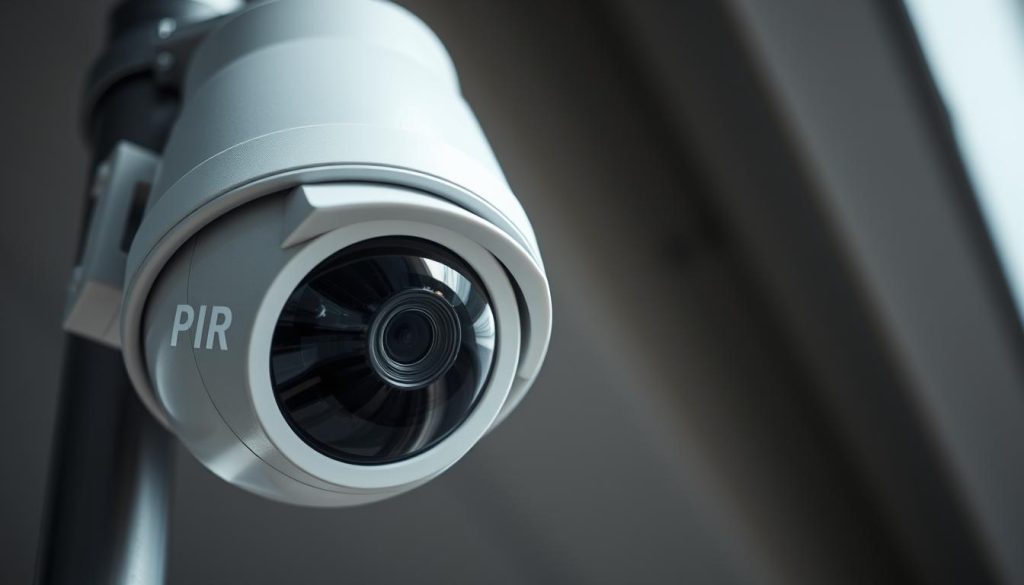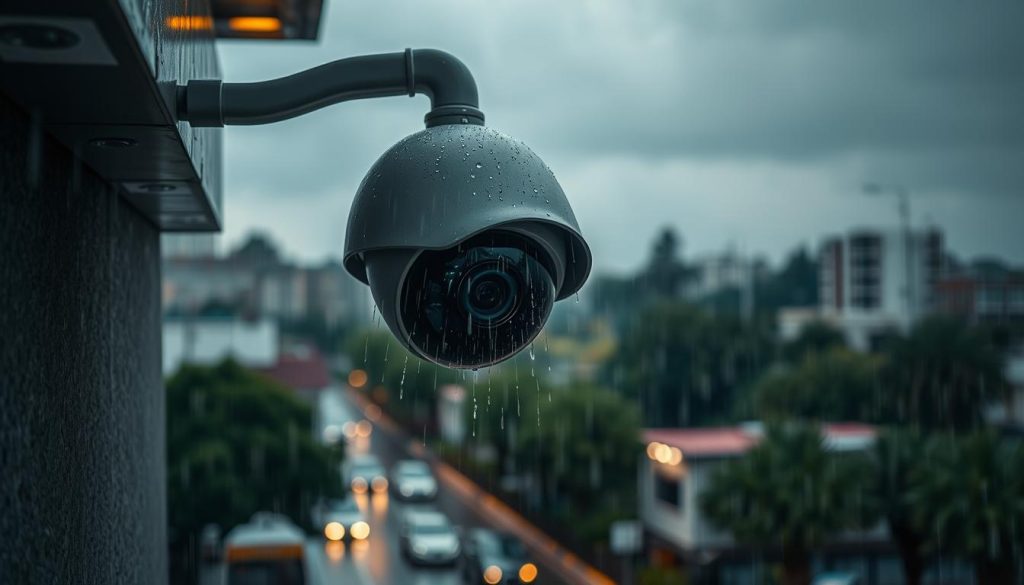In places like Singapore, dealing with heavy rain can be tough. It’s a big challenge to keep your CCTV system working well. Rain often causes false alarms, which can be really frustrating.
Learning about motion detection systems is key. It helps reduce these false alarms. With new tech, you can make your CCTV system better, even in bad weather. For more tips on keeping your system safe from rain, check out this useful article.
Key Takeaways
- Rain can trigger false alarms on CCTV systems.
- Understanding motion detection can enhance performance.
- Effective techniques can minimize disruptions from weather.
- Advancements in technology help improve CCTV functionality.
- Regular maintenance is essential for optimal performance.
Understanding CCTV Motion Detection
CCTV motion detection technology is key for better security. It uses advanced tech to spot movement. When something moves, it takes pictures and checks for changes.
But, CCTV systems can sometimes send out false alarms. This can be really annoying. Many things can cause these mistakes, leading to wasted time and effort.
How Motion Detection Works
Motion detection works by comparing frames. Cameras look for changes to spot movement. But, things like rain can mess with the images, making it think there’s movement when there isn’t.
Common Sources of False Alarms
There are many reasons why CCTV systems might send out false alarms. Some common ones include:
- Sudden changes in lighting, like from car headlights.
- Movement from animals, like pets or wildlife.
- Shifting plants or branches from the wind.
These things can trick the system into thinking there’s a problem when there isn’t.
Why Rain Affects CCTV Performance
Rain can really mess with CCTV systems. It causes problems like image distortion and false motion alerts. Knowing how rain effects on CCTV works is key for those who use surveillance.
When rain hits the camera lens, it gets in the way. This messes up the CCTV image quality. Raindrops make the camera see blurs, not clear images. This makes it hard to tell real movement from rain effects.
Also, rain can mess with night vision. Infrared features can bounce off water, making the camera less effective. This leads to a lot of false alarms, making monitoring very tiring.
How do I stop my CCTV from picking up rain?
Rain can really mess up CCTV systems, causing a lot of false alarms. There are ways to stop this, so your system only alerts you when it should.
Using advanced features in your CCTV system is a good start. Many cameras today have special algorithms to cut down on rain alerts. These algorithms can tell the difference between rain and real movement, making your system more accurate.
Changing your camera settings is also important. You can set the detection levels higher to reduce false alarms from rain. This means the camera will only notice clear movement, cutting down on rain alerts.
There are also physical ways to help. You can put shields or covers on cameras to keep rain off the lens. Or, place cameras under eaves or awnings to avoid rain altogether. These steps can make your CCTV system more reliable and less prone to rain alerts.
Enabling Object Classification
Object classification in CCTV systems has many benefits. It helps identify different objects, making sure important movements are noticed. This reduces false alarms and makes CCTV notifications more reliable.
Benefits of Object Classification
Object classification offers several advantages:
- Enhanced focus: It focuses on key movements, like people or vehicles.
- Reduced alerts: It cuts down on alerts from minor things, like animals or leaves.
- Improved efficiency: It lets security teams focus on real threats.
How to Enable Object Classification on Your CCTV
To turn on object classification on your CCTV, go to the advanced camera settings. The steps might vary, but here’s a basic guide:
- Log in to your CCTV management software or app.
- Go to the settings menu, often called “Camera Settings” or “Motion Detection.”
- Find the object classification section and turn it on.
- Adjust any extra settings to improve detection.
- Save your changes and watch the feed for better results.
Adjusting Detection Zones
To make your CCTV system better, adjusting detection zones is key. By setting up these zones, you can watch over important areas and ignore others. This way, your system works more efficiently and cuts down on false alerts.
Defining Specific Detection Areas
CCTV detection zones let you choose exactly where to watch. You can set up your system to focus on key spots like entrances or driveways. This makes your security better by quickly spotting any activity in these areas.
What to Exclude from the Activity Zone
It’s also vital to leave out certain areas to avoid false alerts. Think about not including:
- Trees and foliage that may sway in the wind
- Busy public spaces where foot traffic is common
- Areas prone to animal activity, like gardens or yards
- Nearby locations with frequent movement from vehicles
By excluding these spots, you lower the chance of getting false alerts. This gives you a clearer view of real activity in your watched zones.
Setting Detection Sensitivity
Finding the right balance in motion detection is key for a good CCTV system. Adjusting the CCTV sensitivity settings helps your cameras catch important movements. This way, they don’t get too excited by small things like rain or leaves.
This balance is important. It helps your cameras watch for real activities like people or cars. But it also keeps them from sending out too many false alarms.
Finding the Right Balance
To make your system better, follow these steps when adjusting camera detection:
- Look at where the camera is placed.
- Change sensitivity based on how much movement there is.
- Try out different settings to see what works best.
- Keep checking and adjusting as things change.
By managing your CCTV sensitivity well, your cameras will work better. They’ll send out fewer false alerts and catch the important stuff.
Adjusting Camera Angles and Installation
Proper camera installation is key to avoiding false rain alerts. By placing cameras right, you cut down on unnecessary alerts during bad weather. Knowing how to place cameras well can make your surveillance better.
Optimal Placement for Reduced Rain Detection
For good surveillance, keep CCTV cameras away from rain. You can do this by:
- Adjusting the camera angle to avoid rain.
- Putting cameras under eaves or awnings for shelter.
- Using weather-resistant enclosures to keep moisture out.
These steps will make your footage clearer and cameras work better in tough weather.
Avoiding Busy Public Areas
It’s smart to not put CCTV cameras in crowded places. This is because lots of movement can cause more false alerts. Here’s what to do instead:
- Point cameras at private areas or specific spots you’re interested in.
- Use PTZ cameras to change focus when needed.
- Check and adjust camera spots often as your area changes.
By picking the right camera angles and avoiding busy spots, you’ll improve your surveillance. This will also cut down on distractions from rain and people in crowded places.
Using Cameras with Built-in PIR Sensors
Cameras with PIR sensors are a smart choice for outdoor surveillance. They use infrared to spot humans and animals, giving better movement detection than old methods. This means fewer false alarms from rain or snow, which is a big plus.
Advantages of PIR Sensors in Outdoor Cameras
PIR technology has many benefits. It focuses on heat from living things, cutting down on false alerts. Plus, it uses less power, which helps the camera last longer. This also means better battery life for wireless cameras, making them reliable.
Recommended Models with PIR Sensors
Choosing the right camera with PIR sensors is key. Look for top brands like TP-Link and Tapo for their PIR tech. They offer solid protection and clear video, making them great choices. If you want strong security, check out these brands and their PIR sensors.

Implementing Weatherproof Solutions
Using weatherproof CCTV solutions is key to keeping your surveillance system working well. Different camera protective measures can help shield your gear from rain and other weather. This not only improves picture quality but also protects your investment from damage.
Adding Protective Covers to Cameras
Adding protective covers is a smart move to make your CCTV system last longer. These covers help block rain and other weather, cutting down on problems. Choose covers that offer strong protection but don’t block your camera’s view.
Sealing Entry Points Against Water
Sealing your CCTV systems is also vital to keep water out. Check your cameras’ entry points and make sure they’re sealed well. This keeps them working in bad weather and makes them last longer. Regular checks for leaks will keep your system running smoothly.
Regular Maintenance and Updates
Keeping CCTV systems working well means regular care and updates. It’s important to update firmware and take care of the cameras. These steps keep the system running smoothly, improve security, and ensure clear images.
Importance of Firmware Updates
Firmware updates are key for several reasons. They add new features, fix problems, and include security fixes. Checking the manufacturer’s website or the camera app helps keep up with updates. These updates can make your system better at detecting things and work with other security tools.
Routine Cleaning to Maintain Clarity
Keeping cameras clean is vital for clear footage. Dust, rain, and pollution can harm the lens and camera body. Cleaning the lens and camera regularly keeps the video quality high. Neglecting this can make your CCTV system less effective.
Alternative Solutions for Improved Clarity
When rain makes it hard to see, it’s time to think about upgrading your CCTV system. New tech can make your surveillance clearer and more reliable, even in bad weather.
Consider Upgrading Your CCTV System
Upgrading your CCTV can really improve how clear your images are. Newer systems use advanced algorithms to cut down on rain interference. This means you get better footage, even when it’s raining.
Choosing these modern options can make a big difference in your security setup’s effectiveness.
Exploring Different Camera Technologies
Looking into new camera tech can also help improve your CCTV system. High-definition imaging and better low-light performance are big pluses. These features ensure you can see what’s going on, no matter the weather.
Expert Tips for Enhanced CCTV Performance
To get the most out of your CCTV system, you need to know about settings and hardware. Start by adjusting your motion detection settings. This can cut down on false alarms from rain.
Use expert tips to set up specific detection zones and adjust sensitivity. This way, only important movements trigger alerts. Tailoring your system is essential for better performance.
Choosing high-quality hardware is also important. Cameras with built-in PIR sensors work well outdoors, even in bad weather. Look for cameras from trusted brands for better image quality and reliability.
Don’t forget about the best installation practices. Place cameras at angles that avoid rain and obstructions for better visibility. Regular maintenance, like cleaning and updates, keeps your system running smoothly.

